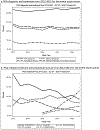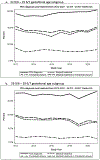Secular Trends in Patent Ductus Arteriosus Management in Infants Born Preterm in the National Institute of Child Health and Human Development Neonatal Research Network
- PMID: 38135028
- PMCID: PMC10922632
- DOI: 10.1016/j.jpeds.2023.113877
Secular Trends in Patent Ductus Arteriosus Management in Infants Born Preterm in the National Institute of Child Health and Human Development Neonatal Research Network
Abstract
We evaluated changes in patent ductus arteriosus (PDA) diagnosis and treatment from 2012 through 2021 in a network of US academic hospitals. PDA treatment decreased among infants born at 26-28 weeks but not among infants born at 22-25 weeks. Rates of indomethacin use and PDA ligation decreased while acetaminophen use and transcatheter PDA closure increased.
Keywords: patent ductus arteriosus; preterm infant; secular trends.
Copyright © 2024 Elsevier Inc. All rights reserved.
Conflict of interest statement
Declaration of Competing Interest D.C.K. serves as a consultant for ONY Biotech Inc. C.H.B. has following disclosures; Abbott Laboratories: funding of ongoing multicenter trial, in partnership with National Institutes of Health, entitled PIVOTAL (NCT05547165). Abbott Laboratories has no part in the design or execution of PIVOTAL. P.J.M. serves as a consultant for Abbot Laboratories and Aspect Ltd. The other authors declare no conflicts of interest.
Figures
References
-
- Benitz WE. Treatment of persistent patent ductus arteriosus in preterm infants: time to accept the null hypothesis? J Perinatol. 2010;30: 241–52. - PubMed
-
- Altit G, Saeed S, Beltempo M, Claveau M, Lapointe A, Basso O. Outcomes of extremely premature infants comparing patent ductus arteriosus management approaches. J Pediatr. 2021;235:49–57.e2. - PubMed
-
- Relangi D, Somashekar S, Jain D, Vanbuskirk S, Bancalari E, Sosenko I, et al. Changes in patent ductus arteriosus treatment strategy and respiratory outcomes in premature infants. J Pediatr. 2021;235:58–62. - PubMed
MeSH terms
Substances
Grants and funding
- UG1 HD068263/HD/NICHD NIH HHS/United States
- L40 HD099827/HD/NICHD NIH HHS/United States
- UG1 HD087226/HD/NICHD NIH HHS/United States
- UG1 HD068270/HD/NICHD NIH HHS/United States
- UG1 HD027856/HD/NICHD NIH HHS/United States
- UG1 HD034216/HD/NICHD NIH HHS/United States
- UL1 TR000454/TR/NCATS NIH HHS/United States
- UG1 HD027904/HD/NICHD NIH HHS/United States
- UL1 TR001117/TR/NCATS NIH HHS/United States
- UG1 HD053109/HD/NICHD NIH HHS/United States
- UG1 HD027851/HD/NICHD NIH HHS/United States
- U01 HD036790/HD/NICHD NIH HHS/United States
- F32 HD098782/HD/NICHD NIH HHS/United States
- UG1 HD068244/HD/NICHD NIH HHS/United States
- UG1 HD027853/HD/NICHD NIH HHS/United States
- UG1 HD112093/HD/NICHD NIH HHS/United States
- UL1 TR000042/TR/NCATS NIH HHS/United States
- UG1 HD087229/HD/NICHD NIH HHS/United States
- UG1 HD040689/HD/NICHD NIH HHS/United States
- UL1 TR001449/TR/NCATS NIH HHS/United States
- UG1 HD053089/HD/NICHD NIH HHS/United States
- UL1 TR000442/TR/NCATS NIH HHS/United States
- UL1 TR001108/TR/NCATS NIH HHS/United States
- UL1 TR001085/TR/NCATS NIH HHS/United States
- UG1 HD068284/HD/NICHD NIH HHS/United States
- UG1 HD021385/HD/NICHD NIH HHS/United States
- UL1 TR001425/TR/NCATS NIH HHS/United States
- UG1 HD040492/HD/NICHD NIH HHS/United States
- UG1 HD021364/HD/NICHD NIH HHS/United States
- UG1 HD027880/HD/NICHD NIH HHS/United States
- UL1 TR000105/TR/NCATS NIH HHS/United States
- UG1 HD068278/HD/NICHD NIH HHS/United States
- U24 HD095254/HD/NICHD NIH HHS/United States
LinkOut - more resources
Full Text Sources



